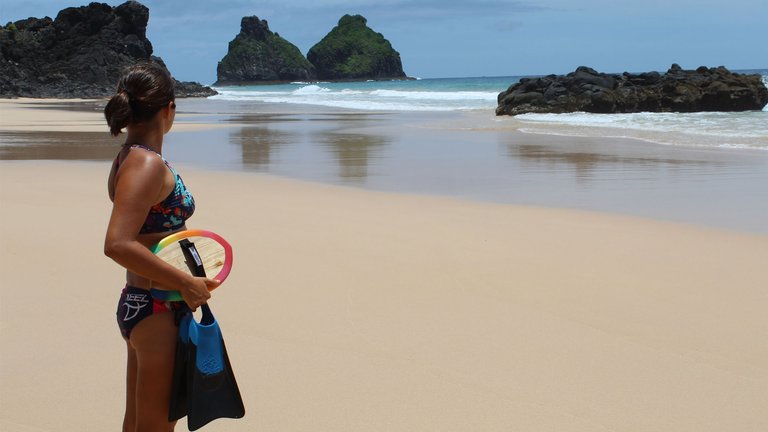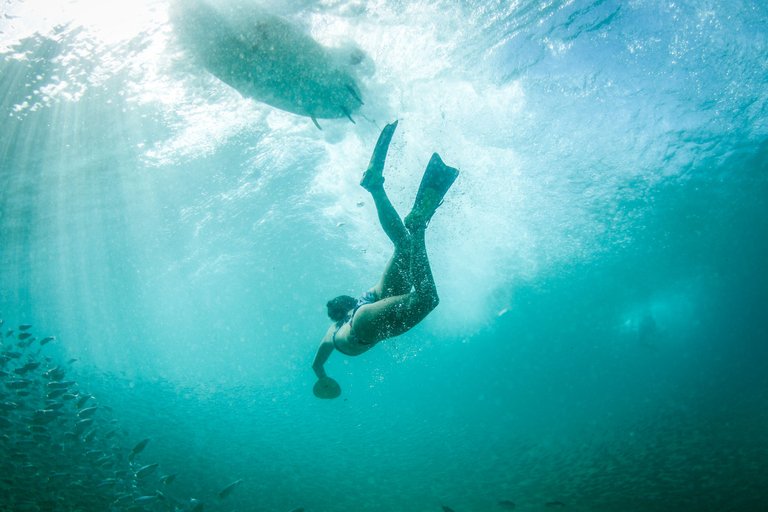English [🇺🇸]
Hi everyone!
There are those who say that bodysurfing is the type of sport that does not pose any risk. But how could such a statement be true if we take into account everything that involves the practice of this ancient sport? Starting with the environment where it is practiced: the sea. An unpredictable place, where natural factors can completely affect the conditions you find there when you arrive.
In a moment you will find excellent conditions to surf and have fun safely. You can quickly fall into a rip current and find yourself in an unpleasant situation that could cost you your life. Although they have fins and these are very useful for moving around and getting out of a rip current, not all bodysurfers are prepared to think under pressure and deal with the current.

Photo: Are there any dangers for bodysurfers?
That's why it's so important to have knowledge about the sea, waves, rip currents and know how to read the entire panorama. This should start out of the water, studying wave forecasts, watching informative videos about the variables that influence the sea, etc. And as soon as you step on the sand, turn on alert mode and watch the sea as it warms up to enter the sea.
Certainly, the rip current is a great danger for breast surfers, who in addition to all this do not have a floating object to support themselves and wait for help/rescue (as is the case with those who surf with surfboards, bodyboarding, SUP and etc.).
Another risk that involves bodysurfing fans is the high incidence of ear infections and inflammation. This occurs because we are constantly in contact with the water, unlike surfers who can wait sitting or lying on their boards.
So it's natural that our ear canal suffers much more from the action of wind, low temperatures and the water itself. A good way to avoid unpleasant situations like this that end up preventing us from keeping our health up to date is to use ear protectors. Currently, there are different ear protectors that are often used by swimmers, as well as specific protectors for those who surf.
Because swimming is the base sport of bodysurfing, that is, we move in the sea swimming crawl, we often enter the wave doing the stroke and kick of the butterfly stroke, we use the shoulder joint a lot. Therefore, the incidence of shoulder injuries in bodysurfers, such as tendonitis, bursitis and shoulder impingement syndrome, is common.

Photo: One of the biggest dangers for bodysurfers is the keel of the surfers' board, recorded by Maíra Kellermann.
Although we do not have scientific data to prove this high incidence, we see and hear many reports of chest surfers with such problems. In this case, the way forward is prevention and strengthening of the joint. More than anything, prevent rather than cure and therefore physical exercise out of water is necessary.
To close the main risks involved in the practice of bodysurfing, the keel proves to be a very dangerous object. Because we are, most of the time, with only our heads above water, surfers end up having difficulty seeing us. And with this it is clear that accidents occur at different times. For example, a bodysurfer breaking a wave at the same time as the surfer passes by doing the bottom turn.
Or when a surfer tries a maneuver and loses control of the board, it becomes loose and can hit the surfer in the chest. The keel in general is the greatest danger when we evaluate all parts of the board, as it is an extremely sharp, cutting object, capable of causing deep injuries.
Furthermore, this column is not intended to scare bodysurfers away from the sea. It serves as a warning so that everyone, both beginners and advanced, knows that bodysurfing is not a sport for amateurs. We need to be careful, we need to be attentive and try to anticipate the risks we may face one day.
Find out about rip currents, know how to read the sea before entering, try to take care of the health of your ears and your shoulder, as well as be careful with the crowd and boards in general. But one thing is certain: know how to distinguish between what is dangerous and what is a figment of your imagination. And don't stop going to the sea, don't feel afraid to the point of paralyzing and giving up surfing.
Aloha, see you soon!
About me My social networks: Aloha, galera! Há quem diga que o bodysurf é o tipo de esporte que não oferece risco algum. Mas como tal afirmação poderia ser verdadeira se levarmos em consideração tudo o que envolve a prática desse esporte milenar? Começando pelo ambiente onde o mesmo é praticado: o mar. Um local imprevisível, onde fatores naturais podem afetar completamente as condições que você ali encontrou ao chegar. Em um momento você encontra condições excelentes para surfar e se divertir com segurança. Rapidamente você pode cair em uma corrente de retorno e se deparar com uma situação desagradável, que pode custar a sua vida. Apesar de portar nadadeiras e estas serem de grande utilidade para se deslocar e assim sair de uma corrente de retorno, nem todos os bodysurfers estão preparados para pensar sob pressão e lidar com a correnteza. Foto: Existem perigosos para os bodysurfers? Por isso é tão importante ter conhecimentos sobre o mar, as ondas, correntes de retorno e saber fazer a leitura de todo o panorama. Isso já deve começar fora d’água, estudando previsões de onda, assistindo vídeos informativos sobre as variáveis que influenciam o mar e etc. E assim que pisar na areia, ligar o modo alerta e observar o mar enquanto está se aquecendo para entrar no mar. Certamente, a corrente de retorno é um grande perigo para os surfistas de peito, que além de tudo isso não dispõem de um objeto flutuante para se apoiarem e aguardarem ajuda / resgate (como é o caso daqueles que surfam com pranchas de surfe, bodyboarding, SUP e etc). Outro risco que envolve os adeptos do bodysurf é a elevada incidência de infecções e inflamações nos ouvidos. Isso ocorre porque ficamos constantemente em contato com a água, diferente dos surfistas que podem aguardar sentados ou deitados em suas pranchas. Então é natural que nosso canal auditivo sofra muito mais com a ação do vento, temperatura baixa e a própria água. Uma boa saída para evitar situações desagradáveis como essa que acabam por nos impedir de estar com a saúde em dia, é a utilização de protetores de ouvidos. Atualmente, existem diferentes protetores de ouvido que costumam ser muito utilizados por nadadores, assim como há protetores específicos para aqueles que surfam. Pelo fato da natação ser o esporte base do bodysurf, isto é, nos deslocamos no mar nadando de crawl, entramos na onda muitas vezes fazendo a braçada e a pernada do nado borboleta, utilizamos muito a articulação do ombro. Por isso, torna-se corriqueira a incidência de lesões no ombro de bodysurfers como tendinite, bursite, síndrome do impacto do ombro. Foto: Um dos maiores perigos para bodysurfers é a quilha da prancha dos surfistas, registrado por Maíra Kellermann. Embora não tenhamos dados científicos que comprovem essa alta incidência, vemos e ouvimos muitos relatos de surfistas de peito com tais problemas. Nesse caso, o caminho é a prevenção e fortalecimento da articulação. Mais do que tudo, prevenir ao invés de remediar e assim o exercício físico fora d’água se faz necessário. Para fechar os principais riscos que envolvem a prática do bodysurf, a quilha se mostra como um objeto muito perigoso. Por estarmos, a maior parte do tempo, apenas com a cabeça acima d’água, os surfistas acabam tendo dificuldade para nos enxergar. E com isso é claro que acidentes ocorrem, em diferentes momentos. Como por exemplo, um bodysurfer furando uma onda ao mesmo tempo em que o surfista passa fazendo o bottom turn. Ou então quando um surfista vai tentar uma manobra e perde o controle da prancha, com isso ela fica solta e pode atingir o surfista de peito. A quilha em geral é o grande perigo quando avaliamos todas as partes da prancha, pois é um objeto extremamente afiado, cortante, capaz de causar profundas lesões. No mais, essa coluna não tem a intenção de assustar e afastar bodysurfers do mar. Serve como um alerta para que todos, tanto os iniciantes como os avançados, saibam que o bodysurf não é esporte para amadores. É preciso ter cuidado, é preciso estar atento e procurar se antecipar aos riscos que podemos enfrentar algum dia. Informe-se sobre corrente de retorno, saiba ler o mar antes de entrar, procure cuidar da saúde do seu ouvido e do seu ombro, assim como ter atenção com o crowd e as pranchas em geral. Mas uma coisa é certa: saiba distinguir o que é perigoso e o que é fruto da sua imaginação. E não deixe de ir ao mar, não sinta medo a ponto de paralisar e desistir de surfar. Aloha, até a próxima! Sobre mim Minhas redes sociais:
Physical education teacher, PhD student, content creator, bodysurfer and nature lover. Get to know me better here!
Instagram: @parada.leticia
YouTube: Ela No Mar
LinkedIn: https://br.linkedin.com/in/leticia-parada-657883249
Português [BR]


Professora de educação física, doutorado em andamento, criadora de conteúdo, bodysurfer e amante da natureza. Clica aqui pra me conhecer melhor!
Instagram: @parada.leticia
YouTube: Ela No Mar
LinkedIn: https://br.linkedin.com/in/leticia-parada-657883249
Obrigado por promover a comunidade Hive-BR em suas postagens.
Vamos seguir fortalecendo a Hive
De nada 😊
Your post was manually curated by @CrazyPhantomBR.
Delegate your HP to the hive-br.voter account and earn Hive daily!
🔹 Follow our Curation Trail and don't miss voting! 🔹
Mahalo
Congratulations @paradaleticia! You have completed the following achievement on the Hive blockchain And have been rewarded with New badge(s)
Your next target is to reach 9000 upvotes.
You can view your badges on your board and compare yourself to others in the Ranking
If you no longer want to receive notifications, reply to this comment with the word
STOPCheck out our last posts:
Nice 😀